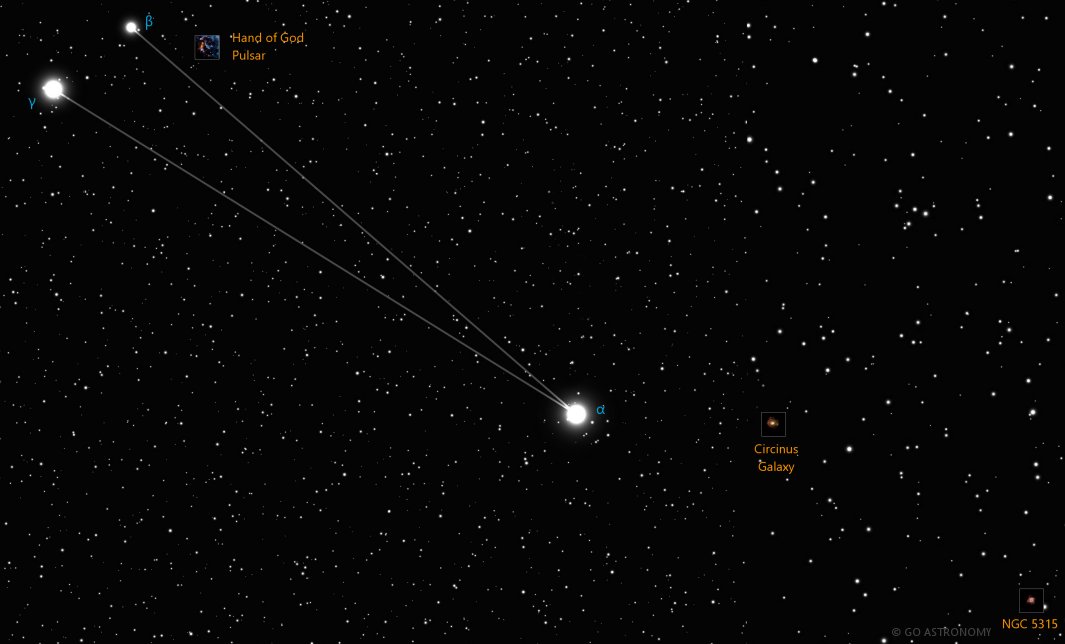Circinus, the Drafting Compass (Cir)
(SIR-sin-us)
The Southern constellation of Circinus, the Drafting Compass, is best viewed in Summer during the month of June.
Circinus is the 85th largest constellation. It's brightest star is Alpha Circini at magnitude 3.19. The boundary of the Circinus constellation contains 3 stars that host known exoplanets.
Circinus is a circumpolar constellation, so is visible year-round in the Southern hemisphere. Conversely, it is not visible in the opposite hemisphere.
- Pronunciation:
- SIR-sin-us
- Meaning:
- Drafting Compass
- Genitive:
- Circini
- Abbreviation:
- Cir
- Constellation Family:
- LaCaille
- Hemisphere:
- Southern
- Quadrant:
- SQ3
- Visibility:
- 30° N - 90° S
- Best viewing month*:
- June
- Area:
- 93 sq. degrees
- Size:
- 85th largest
- Circumpolar** (N=northern, S=southern):
- S circumpolar
- Right Ascension (avg):
- 14h 32m
- Declination (avg):
- -64°
- Brightest star:
- Alpha Circini (3.19)
- Stars with planets:
- 3
- X-ray stars:
- 4 (2 binaries) stars
- Messier objects:
- |
Brightest Stars in Circinus
The 10 brightest stars in the constellation Circinus by magnitude.
- Star
- Magnitude
- Spectral class
- Alpha Circini (α Cir)
- 3.18
- F1Vp
- Beta Circini (β Cir)
- 4.07
- A3Va
- Gamma Circini (γ Cir)
- 4.48
- B5III + F8
- Epsilon Circini (ε Cir)
- 4.85
- K2.5III
- Delta Circini (δ Cir)
- 5.04
- O8.5V
- Theta Circini (θ Cir)
- 5.08
- B4Vnp
- Eta Circini (η Cir)
- 5.16
- G8III
- HD 131342
- 5.18
- K1III
- HD 129422
- 5.36
- A7Vn
- HD 135591
- 5.43
- O7Iab
Galaxies in Circinus
The most notable galaxies in the constellation Circinus . Also see all galaxies.
Neutron Stars in Circinus
These are the most well-known neutron stars in the constellation Circinus. Although neutron stars cannot be seen in any amateur telescope, they are at the center of many supernova remnant nebulae, which can be seen. Also see all neutron stars.
The Compass of the Night Sky
The constellation Circinus, Latin for 'the compass,' is a small constellation located in the southern celestial hemisphere. The constellation represents the drawing tool used for making circles and was named by the French astronomer Nicolas Louis de Lacaille in the 18th century during his expedition to the Cape of Good Hope.
Historical Overview
Circinus is one of the 14 constellations named by Lacaille, who dedicated his life to mapping the southern sky. He named most of these constellations after tools and instruments of science and art, and Circinus was no exception, symbolizing the draftsman's compass. Lacaille's constellations, including Circinus, were officially recognized by the International Astronomical Union (IAU) in 1930.
Location and Notable Features
Circinus is located in the second quadrant of the southern hemisphere (SQ2) and is visible at latitudes between +30? and -90?. It is a tiny constellation, ranked 85th in size among the 88 constellations, making it one of the smallest. It is bordered by Centaurus, Apus, Musca, Triangulum Australe, Norma, and Lupus.
Despite its small size, Circinus hosts some notable stars. Alpha Circini is the brightest star in the constellation with an apparent magnitude of 3.19. It's a variable star and a close binary system, located approximately 53.5 light years from Earth. Beta Circini, the second brightest star, has an apparent magnitude of 4.07 and is a white dwarf situated about 100 light-years away.
Deep Sky Objects
Circinus is rich in deep-sky objects, featuring a number of galaxies, nebulae, and other celestial bodies. One of the most notable is the Circinus Galaxy (ESO 97-G13), an active Seyfert galaxy discovered in the 1970s. It's one of the closest galaxies to the Milky Way, lying at a distance of about 13 million light-years away. Despite its proximity, it is challenging to observe due to its location in the Zone of Avoidance, an area of the sky that is obscured by the densest parts of the Milky Way.
Additionally, the constellation is home to the Circinus X-1, an X-ray binary star system that consists of a neutron star orbiting a star similar to the Sun. It is one of the brightest X-ray sources in the sky and the first X-ray source discovered in Circinus.
Observing Circinus
Due to its location, Circinus is visible primarily from the southern hemisphere and low latitudes of the northern hemisphere. The best time to observe Circinus is during culmination in late spring. However, because of its faint stars and small size, it might be challenging to spot without a star chart.
To locate Circinus, observers can find the bright constellation of Centaurus and the Southern Cross (Crux) ? Circinus is to the west of Centaurus and to the east of the apex of the triangle in Triangulum Australe.
While viewing deep-sky objects within Circinus, such as the Circinus Galaxy or Circinus X-1, requires a telescope and dark skies, the exploration of this constellation provides a fascinating journey through the wonders of our universe.
* Constellation shown for northen hemisphere skies. For the southern hemisphere, constellations appear rotated 180 degrees (upside-down and left-right reversed) from what is shown. Remember that seasons are reversed too - summer in northern latitudes is winter in southern latitudes.
** Circumpolar constellations are visible year-round in the hemisphere listed (and not at all in the opposite hemisphere).





